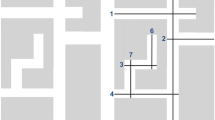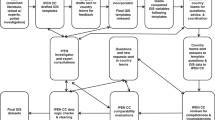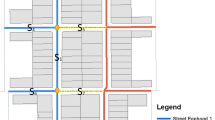Abstract
We investigated the validity of Walk Scores and Transit Scores from the Walk Score website using several objective geographic information systems (GIS) measures of neighborhood walkabiltiy and transit availability based on 400- and 800-m street network buffers. Address data come from the 2008 Boston Youth Survey Geospatial Dataset, a school-based sample of public high school students in Boston, MA with complete residential address information (n = 1,292). GIS data were used to create multiple objective measures of neighborhood walkability and transit availability. We also obtained Walk Scores and Transit Scores. We calculated Spearman correlations of Walk Scores and Transit Scores with the GIS neighborhood walkability/transit availability measures as well as Spearman correlations accounting for spatial autocorrelation. Several significant correlations were observed between Walk Score and 400-m buffer GIS measures of neighborhood walkability; all significant correlations were found for the 800-m buffer. All correlations between Transit Scores and GIS measures of neighborhood transit availability were also significant (all p < 0.0001). However, the magnitude of correlations varied by the GIS measure and neighborhood definition. Relative to the 400-m buffer, correlations for the 800-m buffer were higher. This study suggests that Walk Score is a good, convenient tool to measure certain aspects of neighborhood walkability and transit availability (such as density of retail destinations, density of recreational open space, intersection density, residential density and density of subway stops). However, Walk Score works best at larger spatial scales.


Similar content being viewed by others
References
Azrael, D., Johnson, R. M., Molnar, B. E., Vriniotis, M., Dunn, E. C., Duncan, D. T., et al. (2009). Creating a youth violence data system for Boston, Massachusetts. Australian and New Zealand Journal of Criminology, 42(3), 406–421.
Bailey, T. C., & Gatrell, A. C. (1995). Interactive spatial data analysis. Harlow Essex, England: Longman Scientific & Technical, Wiley.
Ball, K., Jeffery, R. W., Crawford, D. A., Roberts, R. J., Salmon, J., & Timperio, A. F. (2008). Mismatch between perceived and objective measures of physical activity environments. Preventive Medicine, 47(3), 294–298.
Brewer, C., & Harrower, M. (2011). Color Brewer 2.0. Available at: http://www.colorbrewer2.org. Accessed December 1, 2011.
Brownson, R. C., Hoehner, C. M., Day, K., Forsyth, A., & Sallis, J. F. (2009). Measuring the built environment for physical activity: State of the science. American Journal of Preventive Medicine, 36(4 Suppl), S99-123.e12.
Carr, L. J., Dunsiger, S. I., & Marcus, B. H. (2010). Walk score™ as a global estimate of neighborhood walkability. American Journal of Preventive Medicine, 39(5), 460–463.
Carr, L. J., Dunsiger, S. I., & Marcus, B. H. (2011). Validation of Walk Score for estimating access to walkable amenities. British Journal of Sports Medicine, 45(14), 1144–1148.
Cerin, E., Leslie, E., du Toit, L., Owen, N., & Frank, L. D. (2007). Destinations that matter: Associations with walking for transport. Health & Place, 13(3), 713–724.
Clifford, P., & Richardson, S. (1985). Testing the association between two spatial processes. Statistics and Decisions 2(Supp. issue), 155–160.
Delmelle, E. (2009). Spatial sampling. In A. S. Fotheringham & P. A. Rogerson (Eds.), The SAGE handbook of spatial analysis (pp. 183–206). London: SAGE Publications.
Ding, D., Sallis, J. F., Kerr, J., Lee, S., & Rosenberg, D. E. (2011). Neighborhood environment and physical activity among youth: A review. American Journal of Preventive Medicine, 41(4), 442–455.
Downs, T. J., Ogneva-Himmelberger, Y., Aupont, O., Wang, Y., Raj, A., Zimmerman, P., et al. (2010). Vulnerability-based spatial sampling stratification for the National Children’s Study, Worcester County, Massachusetts: Capturing health-relevant environmental and sociodemographic variability. Environmental Health Perspectives, 118(9), 1318–1325.
Duncan, D. T., Aldstadt, J., Whalen, J., Melly, S. J., & Gortmaker, S. L. (2011). Validation of Walk Score® for estimating neighborhood walkability: An analysis of four US metropolitan areas. International Journal of Environmental Research and Public Health, 8(11), 4160–4179.
Dunton, G. F., Kaplan, J., Wolch, J., Jerrett, M., & Reynolds, K. D. (2009). Physical environmental correlates of childhood obesity: A systematic review. Obesity Reviews, 10(4), 393–402.
Feng, J., Glass, T. A., Curriero, F. C., Stewart, W. F., & Schwartz, B. S. (2010). The built environment and obesity: A systematic review of the epidemiologic evidence. Health & Place, 16(2), 175–190.
Front Seat. (2011a). Walk Score methodology. Retrieved June 7, 2011, from http://www.walkscore.com/methodology.shtml.
Front Seat. (2011b). Transit Score methodology. Retrieved June 7, 2011, from http://www.walkscore.com/transit-score-methodology.shtml.
Front Seat. (2011c). Walk Score API. Retrieved June 7, 2011, from http://www.walkscore.com/professional/api.php.
Gebel, K., Bauman, A., & Owen, N. (2009). Correlates of non-concordance between perceived and objective measures of walkability. Annals of Behavioral Medicine, 37(2), 228–238.
Gebel, K., Bauman, A. E., Sugiyama, T., & Owen, N. (2011). Mismatch between perceived and objectively assessed neighborhood walkability attributes: Prospective relationships with walking and weight gain. Health & Place, 17(2), 519–524.
Google. (2011). Geolocation API. Retrieved June 7, 2011, from http://code.google.com/apis/gears/api_geolocation.html.
Grafova, I. B., Freedman, V. A., Kumar, R., & Rogowski, J. (2008). Neighborhoods and obesity in later life. American Journal of Public Health, 98(11), 2065–2071.
Haining, R. (1991). Bivariate correlation with spatial data. Geographical Analysis, 23(3), 210–227.
Kirtland, K. A., Porter, D. E., Addy, C. L., Neet, M. J., Williams, J. E., Sharpe, P. A., et al. (2003). Environmental measures of physical activity supports: Perception versus reality. American Journal of Preventive Medicine, 24(4), 323–331.
Krizek, K. J. (2003). Operationalizing neighborhood accessibility for land use-travel behavior research and regional modeling. Journal of Planning Education and Research, 22(3), 270–287.
Lachapelle, U., Frank, L., Saelens, B. E., Sallis, J. F., & Conway, T. L. (2011). Commuting by public transit and physical activity: Where you live, where you work, and how you get there. Journal of Physical Activity and Health, 8(Suppl 1):S72–S82.
Lee, C., & Moudon, A. V. (2006). The 3Ds + R: Quantifying land use and urban form correlates of walking. Transportation Research Part D, 11(3), 204–215.
Lee, C., Moudon, A. V., & Courbois, J. Y. (2006). Built environment and behavior: Spatial sampling using parcel data. Annals of Epidemiology, 16(5), 387–394.
Lovasi, G. S., Moudon, A. V., Pearson, A. L., Hurvitz, P. M., Larson, E. B., Siscovick, D. S., et al. (2008). Using built environment characteristics to predict walking for exercise. International Journal of Health Geographics, 7, 10.
MacDonald, J. M., Stokes, R. J., Cohen, D. A., Kofner, A., & Ridgeway, G. K. (2010). The effect of light rail transit on body mass index and physical activity. American Journal of Preventive Medicine, 39(2), 105–112.
Matthews, S. A., Moudon, A. V., & Daniel, M. (2009). Work group II: Using geographic information systems for enhancing research relevant to policy on diet, physical activity, and weight. American Journal of Preventive Medicine, 36(4 Suppl), S171–S176.
McGinn, A. P., Evenson, K. R., Herring, A. H., Huston, S. L., & Rodriguez, D. A. (2007). Exploring associations between physical activity and perceived and objective measures of the built environment. Journal of Urban Health, 84(2), 162–184.
Saelens, B. E., & Handy, S. L. (2008). Built environment correlates of walking: A review. Medicine and Science in Sports and Exercise, 40(7 Suppl), S550–S566.
Saelens, B. E., & Papadopoulos, C. (2008). The importance of the built environment in older adults’ physical activity: A Review of the literature. Washington State Journal of Public Health Practice, 1(1), 13–21.
Student. (1914). The elimination of spurious correlation due to position in time or space. Biometrika, 10(1), 179–181.
Vargo, J., Stone, B., & Glanz, K. (in press). Google Walkability: A new tool for local planning and public health research? Journal of Physical Activity and Health. Available online: http://journals.humankinetics.com/jpah-in-press/jpah-in-press/google-walkability-a-new-tool-for-local-planning-and-public-health-research. Accessed on November 30, 2011.
Waller, L. A., & Gotway, C. A. (2004). Applied spatial statistics for public health data. Hoboken, NJ: Wiley-Interscience.
Acknowledgments
Color reproduction costs were supported by funds from the Alonzo Smythe Yerby Postdoctoral Fellowship Program at Harvard School of Public Health and the Department of Geography at the University at Buffalo. The 2008 Boston Youth Survey (BYS) was funded by a grant from the Centers for Disease Control and Prevention (Grant # U49CE00740) to the Harvard Youth Violence Prevention Center at Harvard School of Public Health (David Hemenway, PhD, Principal Investigator), and was conducted in collaboration with the Boston Public Health Commission (Barbara Ferrer, Director), Boston’s Office of Human Services (Larry Mayes, Chief), Boston Public Schools (Carol Johnson, Superintendent) and the Office of the Mayor, the Honorable Thomas M. Menino. The survey would not have been possible without the participation of the faculty, staff, administrators and students of Boston Public Schools as well as faculty, staff and students of Harvard School of Public Health and City of Boston employees who participated in survey administration. A grant to Dustin Duncan from Robert Wood Johnson Foundation’s Active Living Research Program (Grant # 67129) supported the development of the BYS geospatial dataset. We thank Jeff Blossom for providing technical assistance with building this dataset.
Author information
Authors and Affiliations
Corresponding author
Rights and permissions
About this article
Cite this article
Duncan, D.T., Aldstadt, J., Whalen, J. et al. Validation of Walk Scores and Transit Scores for estimating neighborhood walkability and transit availability: a small-area analysis. GeoJournal 78, 407–416 (2013). https://doi.org/10.1007/s10708-011-9444-4
Published:
Issue Date:
DOI: https://doi.org/10.1007/s10708-011-9444-4




